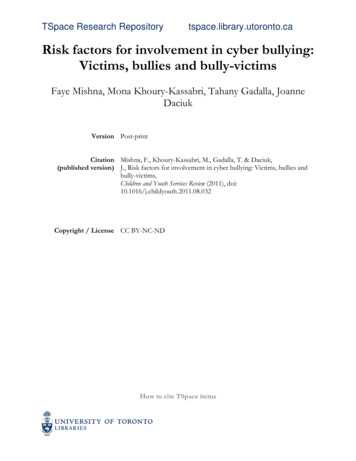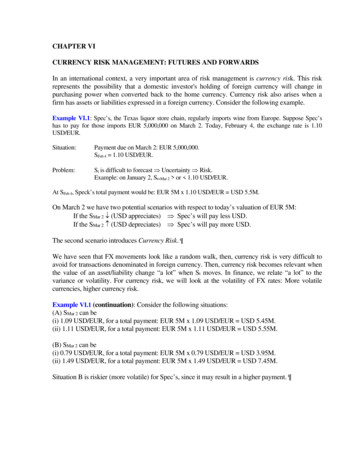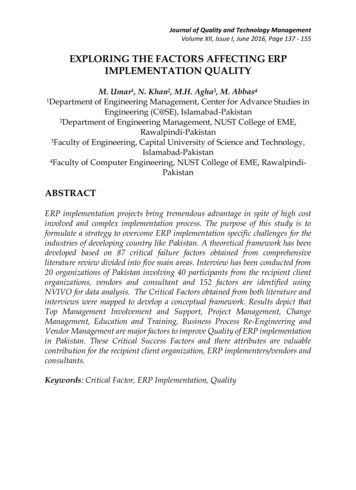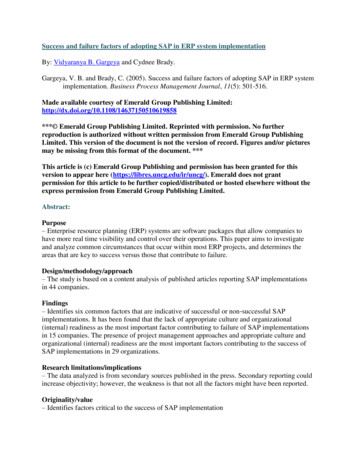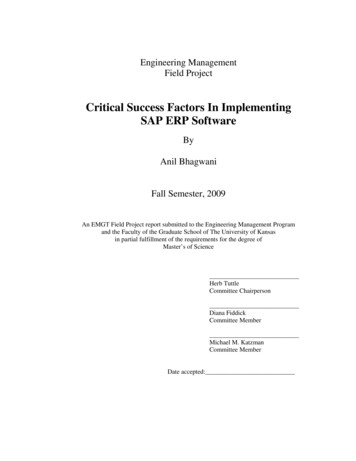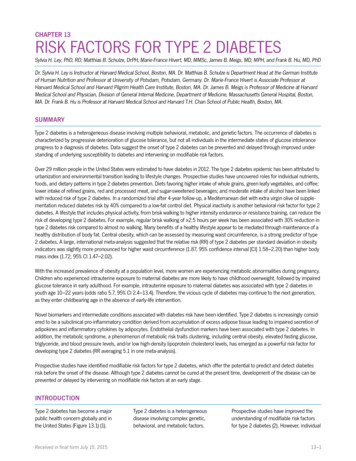
Transcription
CHAPTER 13RISK FACTORS FOR TYPE 2 DIABETESSylvia H. Ley, PhD, RD, Matthias B. Schulze, DrPH, Marie-France Hivert, MD, MMSc, James B. Meigs, MD, MPH, and Frank B. Hu, MD, PhDDr. Sylvia H. Ley is Instructor at Harvard Medical School, Boston, MA. Dr. Matthias B. Schulze is Department Head at the German Instituteof Human Nutrition and Professor at University of Potsdam, Potsdam, Germany. Dr. Marie-France Hivert is Associate Professor atHarvard Medical School and Harvard Pilgrim Health Care Institute, Boston, MA. Dr. James B. Meigs is Professor of Medicine at HarvardMedical School and Physician, Division of General Internal Medicine, Department of Medicine, Massachusetts General Hospital, Boston,MA. Dr. Frank B. Hu is Professor at Harvard Medical School and Harvard T.H. Chan School of Public Health, Boston, MA.SUMMARYType 2 diabetes is a heterogeneous disease involving multiple behavioral, metabolic, and genetic factors. The occurrence of diabetes ischaracterized by progressive deterioration of glucose tolerance, but not all individuals in the intermediate states of glucose intoleranceprogress to a diagnosis of diabetes. Data suggest the onset of type 2 diabetes can be prevented and delayed through improved understanding of underlying susceptibility to diabetes and intervening on modifiable risk factors.Over 29 million people in the United States were estimated to have diabetes in 2012. The type 2 diabetes epidemic has been attributed tourbanization and environmental transition leading to lifestyle changes. Prospective studies have uncovered roles for individual nutrients,foods, and dietary patterns in type 2 diabetes prevention. Diets favoring higher intake of whole grains, green leafy vegetables, and coffee;lower intake of refined grains, red and processed meat, and sugar-sweetened beverages; and moderate intake of alcohol have been linkedwith reduced risk of type 2 diabetes. In a randomized trial after 4-year follow-up, a Mediterranean diet with extra virgin olive oil supplementation reduced diabetes risk by 40% compared to a low-fat control diet. Physical inactivity is another behavioral risk factor for type 2diabetes. A lifestyle that includes physical activity, from brisk walking to higher intensity endurance or resistance training, can reduce therisk of developing type 2 diabetes. For example, regular brisk walking of 2.5 hours per week has been associated with 30% reduction intype 2 diabetes risk compared to almost no walking. Many benefits of a healthy lifestyle appear to be mediated through maintenance of ahealthy distribution of body fat. Central obesity, which can be assessed by measuring waist circumference, is a strong predictor of type2 diabetes. A large, international meta-analysis suggested that the relative risk (RR) of type 2 diabetes per standard deviation in obesityindicators was slightly more pronounced for higher waist circumference (1.87, 95% confidence interval [CI] 1.58–2.20) than higher bodymass index (1.72, 95% CI 1.47–2.02).With the increased prevalence of obesity at a population level, more women are experiencing metabolic abnormalities during pregnancy.Children who experienced intrauterine exposure to maternal diabetes are more likely to have childhood overweight, followed by impairedglucose tolerance in early adulthood. For example, intrauterine exposure to maternal diabetes was associated with type 2 diabetes inyouth age 10–22 years (odds ratio 5.7, 95% CI 2.4–13.4). Therefore, the vicious cycle of diabetes may continue to the next generation,as they enter childbearing age in the absence of early-life intervention.Novel biomarkers and intermediate conditions associated with diabetes risk have been identified. Type 2 diabetes is increasingly considered to be a subclinical pro-inflammatory condition derived from accumulation of excess adipose tissue leading to impaired secretion ofadipokines and inflammatory cytokines by adipocytes. Endothelial dysfunction markers have been associated with type 2 diabetes. Inaddition, the metabolic syndrome, a phenomenon of metabolic risk traits clustering, including central obesity, elevated fasting glucose,triglyceride, and blood pressure levels, and/or low high-density lipoprotein cholesterol levels, has emerged as a powerful risk factor fordeveloping type 2 diabetes (RR averaging 5.1 in one meta-analysis).Prospective studies have identified modifiable risk factors for type 2 diabetes, which offer the potential to predict and detect diabetesrisk before the onset of the disease. Although type 2 diabetes cannot be cured at the present time, development of the disease can beprevented or delayed by intervening on modifiable risk factors at an early stage.INTRODUCTIONType 2 diabetes has become a majorpublic health concern globally and inthe United States (Figure 13.1) (1).Received in final form July 15, 2015.Type 2 diabetes is a heterogeneousdisease involving complex genetic,behavioral, and metabolic factors.Prospective studies have improved theunderstanding of modifiable risk factorsfor type 2 diabetes (2). However, individual13–1
DIABETES IN AMERICA, 3rd Editionresponses to behavioral and lifestyle riskfactors vary, likely due to many factors,including differences among individuals inphysiology, intervention adherence,and the possibility of complex geneenvironment interactions that are notclearly understood (3). Research on novelbiomarkers and intermediate conditionsassociated with diabetes risk may provideadditional information on the diseaseprogress and etiology (4,5).Despite advances in the field, multiplechallenges and knowledge gaps remain.This chapter reviews developments inunderstanding type 2 diabetes risk factors,limitations of present data, and continuedchallenges involved in investigating riskfactors for diabetes and its causes andconsequences. Cross-sectional nationalsurvey data are included to provide anoverview of demographic characteristicsof those at increased risk of diabetes.Large-scale prospective data from theUnited States are used to discuss genetic,behavioral, and metabolic risk factors fordeveloping type 2 diabetes. Meta-analysesand longitudinal international collaboration data are also included to help fill thegaps and strengthen the discussion.FIGURE 13.1. Age-Standardized Prevalence of Diagnosed Diabetes Among Adults Age 18Years, U.S., 1994, 2000, and 2010No data 4.5%4.5%–5.9%6.0%–7.4%7.5%–8.9% 9.0%199420002010Data are from adults age 18 years based on self-report by telephone survey. Prevalence estimates are agestandardized to the 2000 U.S. Standard Population using age categories 18–44, 45–64, 65–74, and 75 years.SOURCE: Reference 1 and Behavioral Risk Factor Surveillance System 1994, 2000, 201013–2
Risk Factors for Type 2 DiabetesDEMOGRAPHIC RISK FACTORSSEXIn the European Prospective Investigationinto Cancer and Nutrition (EPIC), higherrisk of diabetes in men compared withwomen was observed consistentlyacross different European countries (10).However, this consistency was not as25.9%16.2%4.1%45–64Age (Years)20–44 65SOURCE: Reference 6 and National Health and Nutrition Examination Surveys 2009–2012 estimates applied to2012 U.S. Census data.FIGURE 13.3. Median Age at Diagnosis of Diabetes Among Adult Incident Cases, byRace/Ethnicity, U.S., 092010201103 d on NHANES data, the prevalence ofdiabetes increases with age (Figure 13.2)(6). In most populations, the incidence oftype 2 diabetes is low before age 30 yearsbut increases rapidly and continuouslywith older age (7,8). Prospective observational studies have generally reportedage to be a strong risk factor, independentof major correlated lifestyle risk factors,including obesity. This is a particularconcern at a time when life expectancyis increasing. The International DiabetesFederation estimated that the numberof adults with diabetes in the UnitedStates will increase from 23.7 million in2011 to 29.6 million by 2030 (9), largelyattributed to the population aging. Medianages at diagnosis of diabetes vary amongnon-Hispanic white, non-Hispanic black,and Hispanic Americans based on estimation using data from the National HealthInterview Survey (NHIS) of the NationalCenter for Health Statistics, Centers forDisease Control and Prevention, as illustrated in Figure 13.3 (1).FIGURE 13.2. Estimated Percentage of Adults With Diagnosed and Undiagnosed Diabetes,by Age, U.S., 2012Median (years)Among individuals age 20 years in theUnited States, 29 million people haddiabetes, based on National Healthand Nutrition Examination Surveys(NHANES) 2009–2012 estimatesapplied to 2012 U.S. Census data (6). Adetailed description of prevalence andincidence of type 2 diabetes is providedin Chapter 3 Prevalence and Incidenceof Type 2 Diabetes and Prediabetes.The demographic characteristics ofindividuals with type 2 diabetes aredescribed in Chapter 8 SociodemographicCharacteristics of Persons With Diabetes.This section presents information on theassociation of each of these characteristics as a risk factor for developing type 2diabetes.Data are self-reported from adults age 18–79 years.SOURCE: Reference 1 and National Health Interview Surveys 1997–2011clearly evident in the United States population because the incidence of diabetesamong men compared to women washigher in 2010 but lower in 2013, basedon NHIS data. Table 13.1 summarizes thecrude and age-standardized incidence ofdiagnosed diabetes by sex in the UnitedStates, 1993–2013 (1).RACE AND ETHNICITYNational survey data from 2007–2009 forpeople age 20 years indicate that 7.1%of non-Hispanic whites, 8.4% of AsianAmericans, 11.8% of Hispanics/Latinos,and 12.6% of non-Hispanic blacks haddiagnosed diabetes (6). Thus, diabetesis approximately twice as common innon-Hispanic blacks and Hispanics as innon-Hispanic whites in the United States.Based on national data from 2011–2012,total diabetes prevalence (combiningdiagnosed and undiagnosed diabetes) wasalso found to be twice as high in AsianAmericans as in non-Hispanic whites (11).Ethnic differences can be explained onlyin part by differences in the prevalenceof obesity, behavioral risk factors, andsocioeconomic status (SES). For example,higher risk observed in non-Hispanic blackwomen compared to non-Hispanic whitewomen from the NHANES III was attenuated when controlled for differences13–3
DIABETES IN AMERICA, 3rd Editionin socioeconomic characteristics (12).However, this was not the case amongmen. In the Nurses’ Health Study (NHS),self-reported Asian, Hispanic, and blackethnicity were each associated withhigher diabetes risk compared to whitesafter adjustment for differences in age,body mass index (BMI), family history ofdiabetes, and lifestyle risk factors (i.e.,alcohol consumption, smoking, physicalactivity, and diet) (13). In the MultiethnicCohort Study of volunteers living in Hawaiiand California, diabetes risk for JapaneseAmericans and Pacific Islanders was abouttwo to three times higher compared towhites, and these associations remainedafter adjustment for BMI and education(14). In addition, diabetes prevalencevaries widely among countries worldwide(Figure 13.4) (9). The contributions ofgenetics, migration, and acculturation ontype 2 diabetes risk are discussed later inthis chapter.TABLE 13.1. Crude and Age-Standardized Incidence of Diagnosed Diabetes Per 1,000Population Age 18–79 Years, by Sex, U.S., 1993–2013INCIDENCE (STANDARD andardized19933.8 (0.5)4.2 (0.5)4.8 (0.5)4.9 (0.5)19944.1 (0.5)4.6 (0.6)5.4 (0.5)5.5 (0.6)19953.7 (0.5)4.1 (0.6)5.2 (0.6)5.3 (0.6)19964.0 (0.5)4.4 (0.6)4.9 (0.5)5.0 (0.5)19974.6 (0.5)5.0 (0.5)4.4 (0.4)4.5 (0.4)19985.0 (0.3)5.3 (0.4)5.2 (0.3)5.3 (0.3)19995.5 (0.4)5.9 (0.4)5.2 (0.3)5.3 (0.3)20006.1 (0.4)6.5 (0.4)5.9 (0.3)6.0 (0.3)20016.9 (0.4)7.2 (0.5)6.2 (0.4)6.3 (0.4)20027.1 (0.5)7.4 (0.5)6.8 (0.4)6.8 (0.4)20037.1 (0.5)7.4 (0.5)7.0 (0.4)7.0 (0.4)20047.0 (0.5)7.3 (0.5)7.5 (0.4)7.4 (0.4)20057.3 (0.5)7.4 (0.5)7.8 (0.5)7.7 (0.4)20067.8 (0.5)7.9 (0.5)7.7 (0.5)7.6 (0.5)20078.1 (0.6)8.2 (0.6)8.1 (0.5)7.9 (0.5)20089.2 (0.7)9.1 (0.7)8.2 (0.7)7.9 (0.6)20099.2 (0.7)9.1 (0.7)8.1 (0.6)7.8 (0.6)20108.7 (0.7)8.6 (0.6)8.0 (0.6)7.7 (0.6)20117.1 (0.4)7.0 (0.4)7.9 (0.5)7.5 (0.5)20126.6 (0.4)6.4 (0.4)8.0 (0.5)7.6 (0.5)20136.6 (0.5)6.4 (0.5)7.5 (0.6)7.2 (0.5)Data are age-standardized to the 2000 U.S. Standard Population.SOURCE: Reference 1 and National Health Interview Surveys 1993–2013FIGURE 13.4. Global Prevalence of Diabetes, International Diabetes Federation, 2011 44–55–77–99–12 12Comparative prevalence (%) of diabetes is reported.SOURCE: Reference 9, copyright 2011 International Diabetes Federation, reprinted with permission13–4
Risk Factors for Type 2 DiabetesGENETIC RISK FACTORSDetailed information on genetic riskfactors is provided in Chapter 14 Geneticsof Type 2 Diabetes. This section brieflysummarizes genetics in the developmentof type 2 diabetes and discusses its interaction with environmental risk factors. Afamily history of diabetes has been linkedwith increased risk for type 2 diabetes (15).The concordance rates of type 2 diabetesare about 34%–58% in monozygotic twinsand 12%–20% in dizygotic twins (16,17).Early efforts to identify genetic variantsfor type 2 diabetes heritability in epidemiologic studies involved genome-widelinkage and candidate gene approaches.With the introduction of studies incorporating high-throughput, parallel genotypingtechnologies, including genome-wideassociation studies (GWAS), the field hasrapidly advanced, identifying and replicating multiple novel loci associated withtype 2 diabetes (3,15,18,19,20,21,22,23,24,25,26,27,28), as discussed furtherin Chapter 14. Many common geneticvariants predisposing to type 2 diabetesuncovered initially by GWAS have beenlocated near genes implicated in betacell function (29). Subsequently, geneticvariants implicated in insulin resistancepathways were uncovered by accountin
Over 29 million people in the United States were estimated to have diabetes in 2012. The type 2 diabetes epidemic has been attributed to urbanization and environmental transition leading to lifestyle changes. Prospective studies have uncovered roles for individual nutrients, foods, and dietary patterns in type 2 diabetes prevention. Diets favoring higher intake of whole grains, green leafy vegetables, and

